②. 中国科学院青藏高原 地球科学卓越中心, 北京 100101;
③. 全球变化研究协同创新中心, 北京 100875;
④. 中国科学院大学, 北京 100049)
青藏高原是地球上最大的高原地形,人们很早就认识到大地形的存在将会对现代北半球气候,尤其是亚洲气候的形成产生非常重要的影响[1, 2]。青藏高原通过显著的动力及热力效应实现其对气候系统的调制作用,其热力效应主要表现为高原在冬夏季分别是冷源和热源,对周围大气进行冷却和加热,从而改变大气的热力结构;而动力效应则是作为一个物理屏障对大气环流和水汽传输进行阻碍。传统观点认为,夏季青藏高原的热力效应非常重要[3, 4],而冬季其动力效应较为明显[5, 6],青藏高原大地形的存在对北半球行星波建立、西风急流、亚洲夏季风的爆发和形成、东亚冬季风、内陆干旱及大气粉尘变化都具有极其显著的影响[5~18]。
除了理论意义,青藏高原地形在地质气候的历史演化中也具有重要的现实意义。高原阶段性隆升是晚新生代地球演化历史中最显著的构造活动之一,该隆升被认为是众多地质记录所揭示的亚洲古气候长期演化的重要驱动因素。例如,中国黄土等记录所揭示的东亚冬夏季风以及亚洲内陆干旱化在构造时间尺度上的阶段性增强[9, 19~25],与高原阶段性隆升过程发生时间一致,从侧面支持了理论研究得到的高原气候效应的正确性。当然,古气候演化的地质边界条件并不局限于高原地形变化,以南北冰盖发育[26]和大气二氧化碳浓度降低[27]为代表的全球持续变冷也可能对亚洲气候产生重要影响。但不论如何,青藏高原阶段性隆升在亚洲古气候演化中的作用都是不可忽视的。
随着青藏高原构造记录的累积,人们对高原隆升历史有了更加深入的认识,这种认识为评估青藏高原隆升的古气候效应提供了更详实可靠的边界条件。青藏高原隆升呈现显著的区域性差异特征,高原主体的中部、南部、北部以及边缘地形帕米尔-天山-蒙古等的隆升时限明显不同。作为印度次大陆和欧亚大陆碰撞的产物,青藏高原的中部率先抬升,在30~40Ma已经处于相当规模[28],高原南部以及喜马拉雅山在20~10Ma出现剧烈运动[29, 30],最晚隆升的是高原北部,尤其是东北部区域,其主要隆升时间可以晚至上新世或更晚[31],天山-蒙古一线则被认为是青藏主体北进的副产品,隆升时间同高原北部东北部类似,也主要集中在最近10Ma以来[28, 32]。
依据上述隆升情景,近期研究人员开始利用数值试验评估青藏高原区域性隆升对应的气候效应[33],这些研究充分表明了地质历史中青藏高原对亚洲气候系统演化的影响并不像理论“有山”“无山”研究中所揭示的那么简单。青藏高原不同区域的隆升对亚洲各个气候系统形成演化的影响有显著差异,高原南部及喜马拉雅地形对印度夏季风的影响较为明显[34~36],而东亚季风和内陆干旱气候的形成和变化则更多来自高原北部地形改变的贡献[11, 37~39]。目前,不管是讨论高原整体隆升还是区域性隆升,大多研究都重点关注青藏高原主体的贡献[5, 7, 8]。高原主体如此巨大的地形,理所当然成为解释山地构造气候演化问题的核心。高原周边较小尺度地形的潜在影响往往被忽略。事实上,虽然边缘小地形在规模和高度上远远不及青藏高原主体,其热源作用很难与之相比,但得益于所处特殊位置,很可能对某些气候系统产生重要影响。
以蒙古高原为例,它地处青藏高原北部,北半球西风带核心区内;根据来自ERA-Interim逐月再分析风场资料(详见www.ecmwf.int/en/research/climate-reanalysis/era-interim)得到的现代大气低层环流场分布来看( 图 1),蒙古高原对冬季对流层低层西风的物理阻碍作用比青藏高原主体要明显得多。西风环流主要集中在45°N以北,在东传经过青藏-蒙古区域时,主要受到蒙古地形的阻碍。那么,这种动力阻碍对亚洲西风-冬季风系统到底作用如何?迫切需要数值试验进行理论分析。大气环流模式的模拟结果显示,蒙古地形对西风急流和东亚冬季风有加强作用[40, 41],但结果忽略了海洋的可能影响。基于此,本文利用一个耦合海气模式对蒙古高原对亚洲冬季气候的影响进行再评估,并据此探讨青藏高原等山地的动力气候效应。
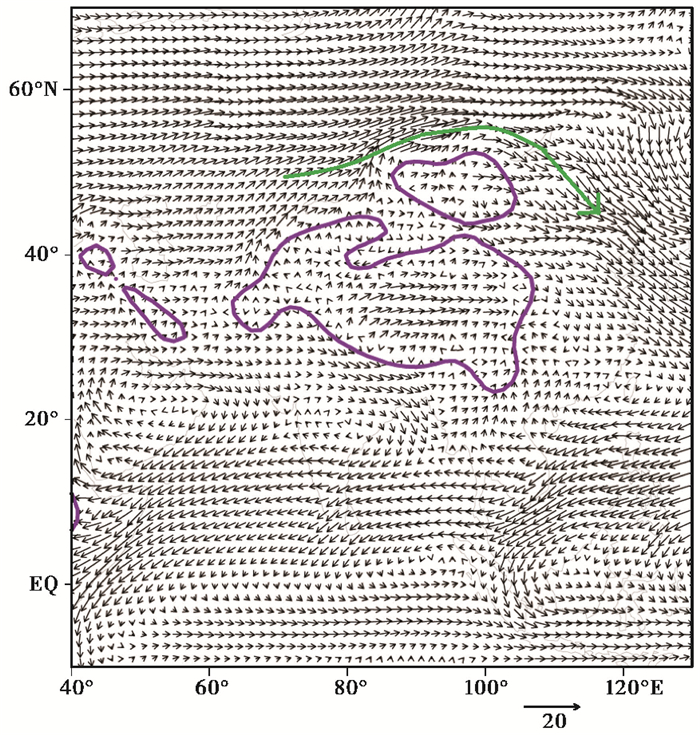
|
图 1 亚洲冬季850 hPa风场(单位:m/s) 绿色箭头显示蒙古高原对低层西风的阻碍作用,海拔超过1500m的地形由紫色实线标出;风场资料来自ERA-Interim逐月再分析资料,水平分辨率为0.75°×0.75°,取1979~2014年冬季平均 Fig. 1 1 850 hPa wind vectors(m/s)during boreal winter over Asia. Green arrow shows the blocking effect of Mongolian Plateau on the low-level westerly winds. Purple line indicates the topography above 1500m a.s.l. The horizontal wind data is from monthly mean ERA-Interim reanalysis, the resolution is 0.75°×0.75°, and is averaged in winter from 1979 to 2014 |
本文采用的海气耦合模式是来自美国国家大气研究中心(NCAR)的通用气候系统模式(Community Climate System Model 3,简称CCSM3)。CCSM3由大气(CAM)、海洋(POP)、陆面(CLM)和海冰(CICE)等模块组成,并通过耦合器实现4个子模块的物质能量交换。试验采用传统的“有山”“无山”对比,即在模式边界地形中保留和降低研究对象地形的海拔高度。为了评估蒙古地形的影响以及同青藏高原主体作对比,本研究共计建立数值试验3个,分别为:控制试验TP1MP1,该试验边界条件保持现代地形分布及海拔;TP1MP0,该试验中青藏高原地形保持不变,蒙古高原范围内地形的海拔高度削减至800m;TP0MP0,该试验中青藏高原及蒙古高原范围内地形都削减至800m。从构造历史上考虑[28, 32],青藏高原主体隆升时间可能早于蒙古高原,3个试验从TP0MP0到TP1MP0再到TP1MP1的过程可能与实际的构造隆升历史更为一致。
本组试验为理想试验,仅考虑现代边界条件下的地形改变对气候模式的强迫作用,其他地质边界的改变,如海陆分布、冰盖范围等都被忽略,大气二氧化碳浓度设定为280ppmv。在模式边界条件的驱动下,海气耦合模式积分了100年,取后15年平均结果来分析气候模式对地形改变的响应。模式水平分辨率为T85_gx1v3,其中大气分辨率约1.4°×1.4°,海洋分辨率经向上不到1°,纬向上可变。由于积分时间的限制,仅表层海温达到平衡(图略),深海热力及动力过程并未平衡,所以该结果仅包含海洋表层温度的反馈。考虑到目前已知大气环流主要受表层海洋变化影响,本试验结果至少反映了亚洲气候对山地地形的一级响应。
3 结果与讨论图 2展示了北半球行星波型对山地地形有无的响应差异,该差异反映了地形对于北半球行星波型的影响大小。在北半球冬季,对流层中高层常表现为“三槽三脊”的型态,欧亚大陆偏西位置为高压脊,而大陆偏东及近海则是东亚大槽所在区域( 图 2a)。当青藏高原主体和蒙古高原两个地形升高后,该行星波型在整个半球尺度被明显加强,东亚大槽明显加深( 图 2b)。该扰动一直延续到远距离地区,在北美上空波型也发生显著变化。

|
图 2 北半球冬季500 hPa位势高度及不同试验差异(单位:10gpm) (a)TP1MP1,(b)TP1MP1-TP0MP0差,(c)TP1MP1-TP1MP0差;(d)TP1MP0-TP0MP0差;(b~d)中黑点为差异置信度超过95 %的区域 Fig. 2 2 500 hPa geopotential height(10gpm)in boreal winter over northern hemisphere and their differences between experiments.(a)TP1MP1; (b)TP1MP1-TP0MP0; (c)TP1MP1-TP1MP0; (d)TP1MP0-TP0MP0. In (b~d), black dotted shows the region where the anomaly significant at the 95 %confidence level |
当地形从TP1MP0变到TP1MP1时,单独增高的蒙古地形同样导致了行星波型的加强( 图 2c)。在亚洲-太平洋区域,行星波型变化最明显,欧亚大陆西部的高压脊增强、东亚大槽加深、西北太平洋副热带高压也有一定加强,这种变化与所有地形的总影响更为接近。对单独青藏高原主体来说,虽然也对大陆高压脊、东亚大槽、西太副高这3个系统有一定的加强作用( 图 2d),但其相对贡献弱于蒙古高原。尤其对于东亚大槽而言,其变化几乎完全来自于蒙古高原地形,青藏高原主体的贡献有限且统计上并不显著。但在北美地区,波型变化则主要受青藏主体的影响。
当同时改变青藏和蒙古两个地形后,整个北半球200 hPa等压面风速都出现变化,尤其在欧亚大陆和北太平洋地区( 图 3b)。地形对风速的影响可以到达北美和大西洋地区,不过有一定程度的削弱。同位势高度场响应一致,在西北太平洋上空出现一个强反气旋异常。对日本上空的西风急流区来说( 图 3a),两个地形可以显著加强该区域的西风风速。但地形对西风的加强作用并不适用于整个中纬度西风带,除了日本西风急流区外,在其他大部分中纬度地区,包括欧亚大陆西部、北美和大西洋区域,西风风速都出现明显的减弱。仅考虑蒙古高原的情况下,200 hPa等压面风矢量和纬向风风速异常的分布同所有地形的效应类似,而变化幅度略小( 图 3c)。日本上空急流区对应西风风速出现明显变化,幅度甚至达到8m/s以上,说明蒙古地形对于西风急流的影响非常显著。在50°N以北的大部分,纬向风都表现为东风异常,表明在这些区域蒙古引起西风减弱。青藏地形引起的风速变化较为有限,在北半球大部分地区,尤其是高纬度地区并不显著( 图 3d)。急流区西风风速有一定增加,但其贡献明显弱于蒙古。
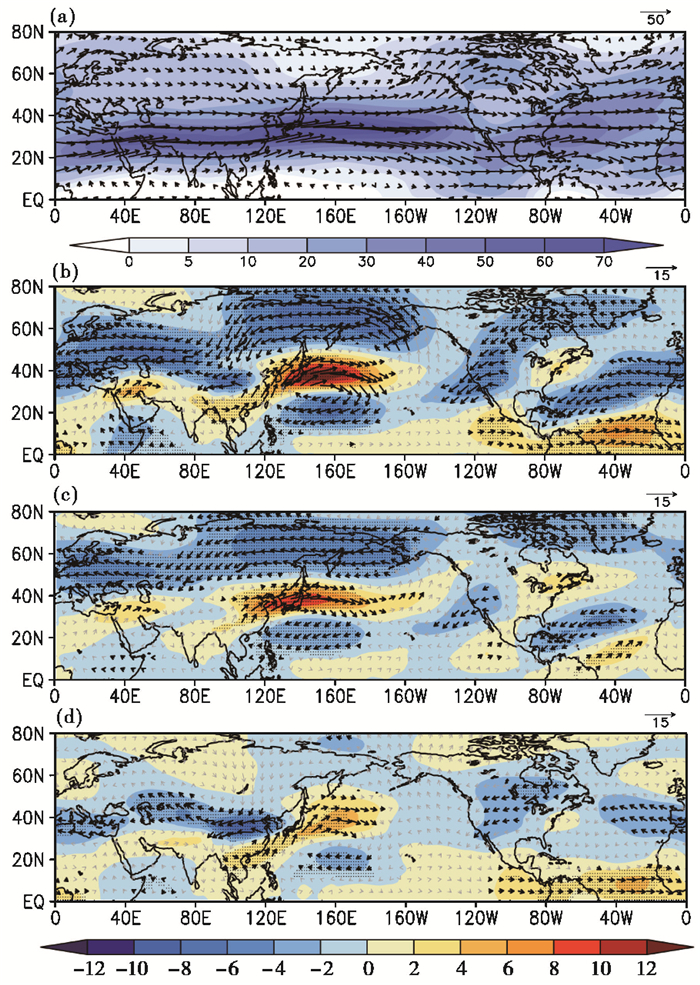
|
图 3 北半球冬季200 hPa风矢量和纬向风速及不同试验差异(单位:m/s) (a)TP1MP1,(b)TP1MP1-TP0MP0差,(c)TP1MP1-TP1MP0差,(d)TP1MP0-TP0MP0差;(a)中黑色箭头表示风矢量均值,(b~d)中黑色箭头和黑点分别为风矢量和纬向风速差异置信度超过95 %的区域 Fig. 3 3 200 hPa wind vectors and zonal wind speeds(m/s) in boreal winter over northern hemisphere and their differences between experiments.(a)TP1MP1; (b)TP1MP1-TP0MP0; (c)TP1MP1-TP1MP0; (d)TP1MP0-TP0MP0. In(a), black arrows indicate the averaged vectors and in (b~d), black arrows and dotted show the region where the anomaly significant at the 95 %confidence level |
除了对流层中高层外,对流层低层的大气环流也受到两高原地形的重要影响。两地形的共同作用使欧亚大陆西部中纬度低层西风减弱,在地形下游的北太平洋产生一个显著的气旋异常中心,该气旋异常在东亚表现为东北风异常( 图 4b)。蒙古地形单独作用与两地形共同作用比较类似,同样在北太平洋引发气旋异常,该气旋异常在我国东北表现为东北风异常,但在华北区域表现为西北风增强,这同我国冬季风的盛行风向一致( 图 4a),表明蒙古地形对东亚冬季风,尤其是华北典型冬季风环流的加强作用( 图 4c)。单独青藏地形的影响则存在差异,在东北地区青藏虽然可以加强偏北风,但并不显著,在华北地区其影响表现为偏西风异常( 图 4d),因此,青藏高原地形并不能显著加强东亚冬季风环流。在印度季风区,青藏可以导致偏西风异常,即对印度冬季风环流存在一定的削弱作用。为了评估海表温度对于蒙古高原气候效应的反馈作用,我们将海气耦合模式试验结果与早前大气环流模式CAM3试验的结果[40, 41]做一简单比较( 图 5)。对于高空西风急流来说,考虑了海表温度反馈后,日本上空西风急流区的200 hPa风速出现进一步加强,且幅度较为显著( 图 5a),这表明海表温度对蒙古高原增强西风急流起到了正反馈作用。但对底层冬季风环流来说,海表温度反馈并不明显( 图 5b)。
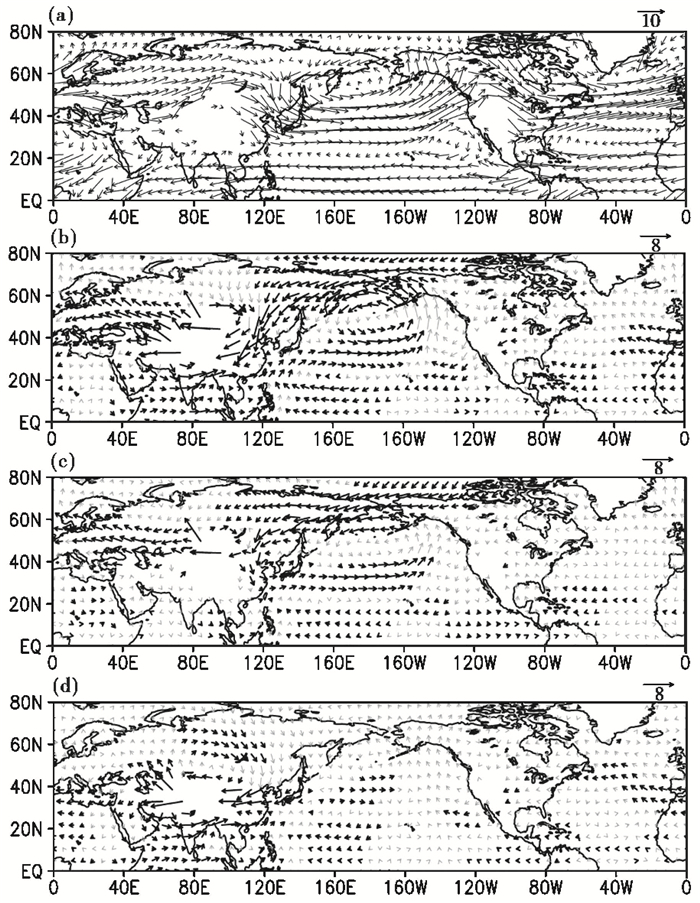
|
图 4 北半球冬季850 hPa风矢量及不同试验差异(单位:m/s) (a)TP1MP1,(b)TP1MP1-TP0MP0差,(c)TP1MP1-TP1MP0差,(d)TP1MP0-TP0MP0差;(a)中黑色箭头表示风矢量均值,(b~d)中黑色箭头为风矢量差异置信度超过95 %的区域 Fig. 4 4 850 hPa wind vectors(m/s) in boreal winter over northern hemisphere and their differences between experiments.(a)TP1MP1; (b)TP1MP1-TP0MP0; (c)TP1MP1-TP1MP0; (d)TP1MP0-TP0MP0. In(a), black arrows indicate the averaged vectors and in (b~d), black arrows show the region where the anomaly significant at the 95 %confidence level |
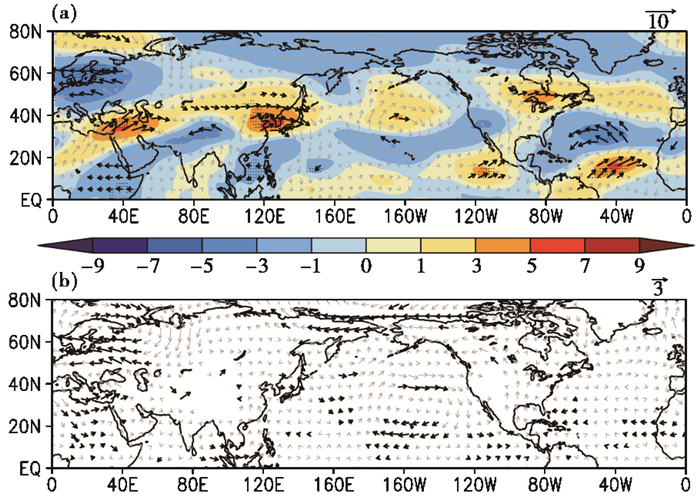
|
图 5 CCSM3与CAM3试验中蒙古高原气候影响的差异(单位:m/s) (a)200 hPa风矢量差(箭头)和纬向风差(阴影),(b)850 hPa风场差(箭头);大气环流模式CAM3试验结果来自文献[40,41],黑色箭头和黑点为风矢量和纬向风差置信度超过95 %的区域 Fig. 5 The differences in the climatic effect of Mongolian Plateau between the CCSM3 and CAM3 experiments(m/s).(a) 200 hPa horizontal wind vectors(arrows) and zonal wind speed(shaded); (b)850 hPa horizontal wind vectors (arrows). Black arrows and dotted show the region where the anomaly in wind vectors and westerly speed significant at the 95 %confidence level |
地形对大气环流的影响主要来自于其对冬季热力结构的调制作用。两地形共同作用导致对流层中层温度发生变化,除了两地形所在区域发生一定降温外,在中亚和东亚的大部分地区也出现变冷,尤其是我国东北和北太平洋偏西地区表现为显著的降温中心( 图 6a)。单独蒙古作用也会导致我国东北地区出现显著降温中心,但幅度略小于两地形共同作用( 图 6b)。这个降温中心与西太平洋变暖放大了二者之间的经向温度差异,从而引起东亚大槽和西风急流的显著变化。对青藏高原来说,温度异常的分布存在不同,首先,我国东北地区的降温幅度较之蒙古高原有所减少,其次,在东亚低纬和西太平洋大部分地区同样呈现一定降温( 图 6c),经向热力对比的增加并没有蒙古高原那么显著。
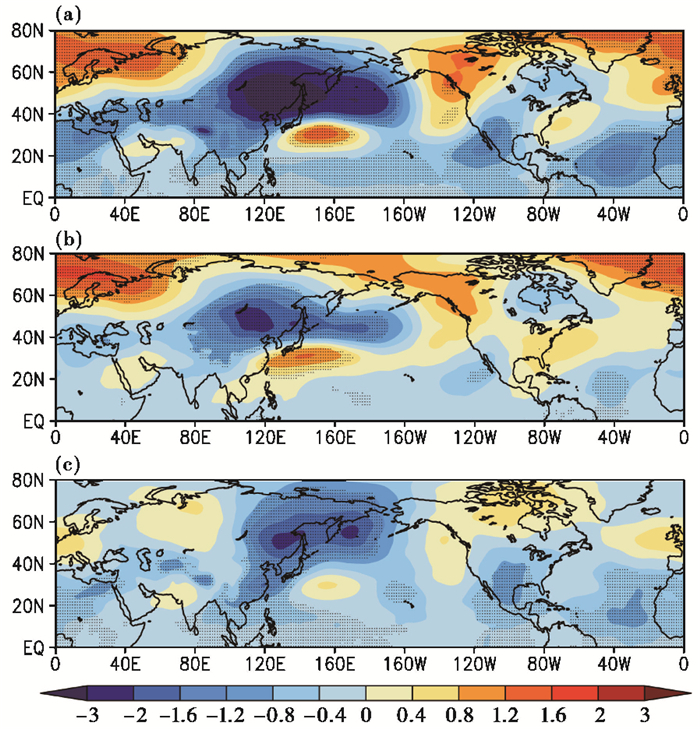
|
图 6 北半球冬季500 hPa温度差异(单位:℃) (a)TP1MP1-TP0MP0差,(b)TP1MP1-TP1MP0差,(c)TP1MP0-TP0MP0差;黑点为差异置信度超过95 %的区域 Fig. 6 Differences in the 500 hPa temperature (℃) in boreal winter over northern hemisphere.(a)TP1MP1-TP0MP0; (b)TP1MP1-TP1MP0; (c)TP1MP0-TP0MP0. Black dotted shows the region where the anomaly significant at the 95 %confidence level |
地形引起的降温中心位置并不在自身区域,而是处在亚洲地形的下游,这说明该降温与地形本身的冷源作用关系有限,相反的,这个降温与地形对西风的动力阻碍作用密切相关。从冬季对流层低层环流分布( 图 1),我们可以看出,蒙古高原虽然规模较小,高度有限,但其位置偏北,处在西风环流核心区。亚洲地形对于冬季西风的动力阻碍作用,尤其对北支西风来说,主要受到蒙古地形的阻碍。西风遇亚洲地形分为南北两支,40°N的西风分量被蒙古高原地形强迫绕流至约60°N,绕过蒙古高原后又南下在太平洋到达40°N乃至30°N。这个显著的北风异常,如图 4c所示,有利于大量极地冷空气南下,引发温度冷平流( 图 7b),从而实现下游区域的温度降低,这与两地形共同作用类似( 图 7a)。但对于青藏高原主体来说,其所处位置纬度较低,离东亚大槽及冬季风系统较远,因此其高纬冷平流效应较弱( 图 7c)。

|
图 7 北半球冬季850 hPa温度平流差异(单位:K·m/s) (a)TP1MP1-TP0MP0差,(b)TP1MP1-TP1MP0差,(c)TP1MP0-TP0MP0差;黑点为差异置信度超过95 %的区域 Fig. 7 Differences in the 850 hPa temperature advection(K·m/s)in boreal winter over northern hemisphere.(a)TP1MP1-TP0MP0; (b)TP1MP1-TP1MP0; (c)TP1MP0-TP0MP0. Black dotted shows the region where the anomaly significant at the 95 %confidence level |
通过上述分析,我们发现蒙古高原地形对西风的阻碍作用可以引发日本西风急流和东亚冬季风非常显著的响应,蒙古对这两个气候系统的影响甚至大于青藏高原主体,从这个角度讲,蒙古高原的动力效应甚至要大于青藏高原主体。海气耦合模式的结果与先前大气环流模式结果[40, 41]一致,表明海洋过程的考虑并不能改变蒙古高原的动力气候效应。本文的讨论并不涉及热力效应,事实上,夏季青藏高原强热源作用对亚洲季风的影响十分显著[3, 4, 35]。在冬季,由于西风位置偏南,其范围已经涵盖整个亚洲高地形区域,西风的绕流现象非常显著。基于数值模拟试验证明,通过西风绕流等机制,亚洲地形的存在可以加强内陆干旱状况、亚洲冬季风和西风急流[5,8,9,11]。但受限于数值模式分辨率等问题,大多理论研究都仅仅关注青藏高原主体地形,而忽略了其周边尺度较小的地形,如蒙古。同样,在古气候研究中,无论是重建记录所揭示的冬季风增强,还是西风增强都被认为是同青藏高原紧密联系[9, 42, 43]。但是,我们的研究显示,对于东亚冬季风和日本西风急流来说,蒙古高原的动力效应可能要大于青藏高原。当然,对于其他气候,比如内陆干旱化,青藏高原的动力效应依然十分重要,其对印度洋水汽的阻碍作用是干旱形成过程中不可或缺的因素之一[8]。另外,新生代以来全球持续变冷,包括南北冰盖发育和大气二氧化碳浓度降低等也是亚洲气候演化过程中的重要强迫[44~47]。但不论如何,本文的结果都暗示我们,传统认识中青藏高原的动力效应很可能被一定程度上高估,动力阻碍作用并不仅仅同地形的范围和高度有关,还受到地形所处位置的显著影响,某些较小尺度地形,由于其位置处在特定气候系统的敏感区内,同样可以对该气候系统产生不可忽略的重要影响。
4 结论本文通过海气耦合模式对蒙古高原地形气候效应的模拟分析,并对比青藏高原主体的相对贡献,得到如下结论:1)蒙古高原地形在高度和规模上都远小于青藏高原主体,但其对亚洲西风急流和冬季风系统的影响十分显著,蒙古地形的出现可以显著加强西风急流和东亚冬季风强度,其影响甚至大于青藏高原主体;2)蒙古高原的气候效应主要来自于其地形对大气低层环流的强迫绕流作用,蒙古高原处于西风带核心区,其对低层西风的阻碍作用较之青藏高原主体更为明显,绕流引发的下游北风异常通过温度平流作用于整个对流层的热力结构,加大经向温度差异,从而造成西风急流和冬季风的明显变化;3)数值试验中蒙古高原显著的动力强迫暗示我们,以往对青藏高原动力效应的认识可能存在一定高估。虽然青藏高原热源对夏季亚洲季风等仍具有重要调制,但对冬季来说,山地地形对于亚洲乃至全球气候系统的影响可能不单单来自于青藏高原主体,处于敏感位置的较小尺度地形同样会产生重大影响。
| 1 |
Bolin B. On the influence of the Earth's orography on the general character of the westerlies.
Tellus,1950, 2 (3) : 184~195.
( 0) 0)
|
| 2 |
叶笃正. 西藏高原对于大气环流影响的季节变化.
气象学报,1952, 23 (Z1) : 33~47.
Yeh Tucheng. The seasonal variation of the influence of the Tibetan Plateau on the general circulation. Acta of Meteorologica Sinica,1952, 23 (Z1) : 33~47. (  0) 0)
|
| 3 |
Yanai M, Li C F, Song Z S. Seasonal heating of the Tibetan Plateau and its effects on the evolution of the Asian summer monsoon.
Journal of the Meteorological Society of Japan,1992, 70 (1B) : 319~351.
( 0) 0)
|
| 4 |
Wu G X, Zhang Y S. Tibetan Plateau forcing and the timing of the monsoon onset over South Asia and the South China Sea.
Monthly Weather Review,1998, 126 (4) : 913~927.
( 0) 0)
|
| 5 |
Kutzbach J E, Guetter P J, Ruddiman W F. Sensitivity of climate to Late Cenozoic uplift in Southern Asia and the American West:Numerical experiments.
Journal of the Geophysical Research,1989, 94 (D15) : 18393~18407.
( 0) 0)
|
| 6 |
Wu G X, Liu Y M, Wang T M, et al. The influence of the mechanical and thermal forcing of the Tibetan Plateau on the Asian climate.
Journal of Hydrometeorology,2007, 8 (4) : 770~789.
( 0) 0)
|
| 7 |
Manabe S, Terpstra T B. The effects of mountains on the general circulation of the atmosphere as identified by numerical experiments.
Journal of the Atmospheric Sciences,1974, 31 (1) : 3~42.
( 0) 0)
|
| 8 |
Manabe S, Broccoli A J. Mountains and arid climates of middle latitudes.
Science,1990, 247 (4939) : 192~195.
( 0) 0)
|
| 9 |
An Z S, Kutzbach J E, Prell W L, et al. Evolution of Asian monsoons and phased uplift of the Himalaya-Tibetan Plateau since Late Miocene times.
Nature,2001, 411 (6833) : 62~66.
( 0) 0)
|
| 10 |
Liu X D, Yin Z Y. Sensitivity of East Asian monsoon climate to the uplift of the Tibetan Plateau.
Palaeogeography, Palaeoclimatology, Palaeoecology,2002, 183 (3-4) : 223~245.
( 0) 0)
|
| 11 |
Shi Z G, Liu X D, An Z S, et al. Simulated variations of eolian dust from Inner Asian deserts at the Mid-Pliocene, Last Glacial Maximum, and present day:Contributions from the regional tectonic uplift and global climate change.
Climate Dynamics,2011, 37 (11) : 2289~2301.
( 0) 0)
|
| 12 |
石正国, 刘晓东, 沙莹莹. 上新世青藏高原北部隆升事件的模拟检验.
地球环境学报,2015, 6 (2) : 67~80.
Shi Zhengguo, Liu Xiaodong, Sha Yingying. Did northern Tibetan Plateau uplift during Pliocene?A modeling test. Journal of Earth Environment,2015, 6 (2) : 67~80. (  0) 0)
|
| 13 |
Jiang D B, Ding Z L, Drange H, et al. Sensitivity of East Asian climate to the progressive uplift and expansion of the Tibetan Plateau under the Mid-Pliocene boundary conditions.
Advances in Atmospheric Sciences,2008, 25 (5) : 709~722.
( 0) 0)
|
| 14 |
Liu Y M, Hoskins B J, Blackburn M. Impact of Tibetan orography and heating on the summer flow over Asia.
Journal of the Meteorological Society of Japan,2007, 85B : 1~19.
( 0) 0)
|
| 15 |
Wu G X, Liu Y M, Dong B W, et al. Revisiting Asian monsoon formation and change associated with Tibetan Plateau forcing:Ⅰ.
Formation. Climate Dynamics,2012, 39 (5) : 1169~1181.
( 0) 0)
|
| 16 |
Wu G X, Guan Y, Liu Y M, et al. Air-sea interaction and formation of the Asian summer monsoon onset vortex over the Bay of Bengal.
Climate Dynamics,2012, 38 (1) : 261~279.
( 0) 0)
|
| 17 |
Wu Guoxiong, Guan Yue, Wang Tongmei, et al. Vortex genesis over the Bay of Bengal in spring and its role in the onset of the Asian summer monsoon.
Science China:Earth Sciences,2011, 54 (1) : 1~9.
( 0) 0)
|
| 18 |
刘晓东, 李力, 安芷生. 青藏高原隆升与欧亚内陆及北非的干旱化.
第四纪研究,2001, 21 (2) : 114~122.
Liu Xiaodong, Li Li, An Zhisheng. Tibetan Plateau uplift and drying in Eurasian interior and North Africa. Quaternary Sciences,2001, 21 (2) : 114~122. (  0) 0)
|
| 19 |
方小敏, 徐先海, 宋春晖, 等. 临夏盆地新生代沉积物高分辨率岩石磁学记录与亚洲内陆干旱化过程及原因.
第四纪研究,2007, 27 (6) : 989~1000.
Fang Xiaomin, Xu Xianhai, Song Chunhui, et al. High resolution rock magnetic records of Cenozoic sediments in the Linxia Basin and their implications on drying of Asian inland. Quaternary Sciences,2007, 27 (6) : 989~1000. (  0) 0)
|
| 20 |
马小林, 田军. 15Ma以来海陆记录的轨道-构造尺度东亚季风的演化以及西北内陆的干旱化.
第四纪研究,2015, 35 (6) : 1320~1330.
Ma Xiaolin, Tian Jun. East Asian monsoon evolution and aridification of Northwest China viewed from land and sea on the tectonic-orbital time scale since15Ma. Quaternary Sciences,2015, 35 (6) : 1320~1330. (  0) 0)
|
| 21 |
李吉均, 方小敏, 潘保田, 等. 新生代晚期青藏高原强烈隆起及其对周边环境的影响.
第四纪研究,2001, 21 (5) : 381~391.
Li Jijun, Fang Xiaomin, Pan Baotian, et al. Cenozoic intensive uplift of Qinghai-Xizang Plateau and its impacts on environments in surrounding area. Quaternary Sciences,2001, 21 (5) : 381~391. (  0) 0)
|
| 22 |
Rea D K, Snoeckx H, Joseph L H. Late Cenozoic eolian deposition in the North Pacific:Asian drying, Tibetan uplift and cooling of the Northern Hemisphere.
Paleoceanography,1998, 13 (3) : 215~224.
( 0) 0)
|
| 23 |
Guo Z T, Ruddiman W F, Hao Q Z, et al. Onset of Asian desertification by22 Myr ago inferred from loess deposits in China.
Nature,2002, 416 (6877) : 159~163.
( 0) 0)
|
| 24 |
安芷生, 张培震, 王二七, 等. 中新世以来我国季风-干旱环境演化与青藏高原的生长.
第四纪研究,2006, 26 (5) : 678~693.
An Zhisheng, Zhang Peizhen, Wang Erchie, et al. Changes of the monsoon-arid environment in China and growth of the Tibetan Plateau since the Miocene. Quaternary Sciences,2006, 26 (5) : 678~693. (  0) 0)
|
| 25 |
强小科, 安芷生, 宋友桂, 等. 晚渐新世以来中国黄土高原风成红粘土序列的发现:亚洲内陆干旱化起源的新记录.
中国科学:地球科学,2010, 40 (11) : 1479~1488.
Qiang Xiaoke, An Zhisheng, Song Yougui, et al. New eolian red clay sequence on the western Chinese Loess Plateau linked to onset of Asian desertification about25Ma ago. Science China:Earth Sciences,2010, 40 (11) : 1479~1488. (  0) 0)
|
| 26 |
Zachos J, Pagani M, Sloan L, et al. Trends, rhythms, and aberrations in global climate65Ma to present.
Science,2001, 292 (5517) : 686~693.
( 0) 0)
|
| 27 |
Pagani M, Zachos J C, Freeman K H, et al. Marked decline in atmospheric carbon dioxide concentrations during the Paleogene.
Science,2005, 22 (5734) : 600~603.
( 0) 0)
|
| 28 |
Molnar P, Boos W R, Battisti D S. Orographic controls on climate and paleoclimate of Asia:Thermal and mechanical roles for the Tibetan Plateau.
Annual Review of Earth and Planetary Sciences,2010, 38 : 77~102.
( 0) 0)
|
| 29 |
Garzione C N, Quade J, DeCelles P G, et al. Predicting paleoelevation of Tibet and the Himalaya from 18O vs. altitude gradients of meteoric water across the Nepal Himalaya.
Earth and Planetary Science Letters,2000, 183 (1-2) : 215~229.
( 0) 0)
|
| 30 |
Spicer R A, Harris N B W, Widdowson M, et al. Constant elevation of southern Tibet over the past15 million years.
Nature,2003, 421 (6923) : 622~624.
( 0) 0)
|
| 31 |
Zheng H B, Powell C M, An Z S, et al. Pliocene uplift of the northern Tibetan Plateau.
Geology,2000, 28 (8) : 715~718.
( 0) 0)
|
| 32 |
Vassallo R, Jolivet M, Ritz J F, et al. Uplift age and rates of the Gurvan Bogd system(Gobi-Altay)by apatite fission track analysis.
Earth and Planetary Science Letters,2007, 259 (3-4) : 333~346.
( 0) 0)
|
| 33 |
刘晓东, DongBuwen. 青藏高原隆升对亚洲季风-干旱环境演化的影响.
科学通报,2013, 58 (34) : 2906~2919.
Liu Xiaodong, Dong Buwen. Influence of the Tibetan Plateau uplift on the Asian monsoon-arid environment evolution. Chinese Science Bulletin,2013, 58 (34) : 2906~2919. (  0) 0)
|
| 34 |
Boos W R, Kuang Z. Dominant control of the South Asian monsoon by orographic insulation versus plateau heating.
Nature,2010, 463 (7278) : 218~222.
( 0) 0)
|
| 35 |
Wu G X, Liu Y M, He B, et al. Thermal controls on the Asian summer monsoon.
Scientific Reports,2012, 2 (5) .
( 0) 0)
|
| 36 |
Tang H, Micheels A, Eronen J T, et al. Asynchronous responses of East Asian and Indian summer monsoons to mountain uplift shown by regional climate modelling experiment.
Climate Dynamics,2013, 40 (5-6) : 1531~1549.
( 0) 0)
|
| 37 |
张冉, 姜大膀, 刘晓东, 等. 喜马拉雅-青藏高原不同子区域隆升对亚洲夏季气候演变影响的数值模拟研究.
科学通报,2012, 57 (35) : 4617~4626.
Zhang Ran, Jiang Dabang, Liu Xiaodong, et al. Modeling the climate effects of different subregional uplifts within the Himalaya-Tibetan Plateau on Asian summer monsoon evolution. Chinese Science Bulletin,2012, 57 (35) : 4617~4626. (  0) 0)
|
| 38 |
Liu X D, Sun H, Miao Y F, et al. Impacts of uplift of northern Tibetan Plateau and formation of Asian inland deserts on regional climate and environment.
Quaternary Science Reviews,2015, 116 : 1~14.
( 0) 0)
|
| 39 |
Zhang R, Jiang D B, Zhang Z S, et al. The impact of regional uplift of the Tibetan Plateau on the Asian monsoon climate.
Palaeogeography, Palaeoclimatology, Palaeoecology,2015, 417 : 137~150.
( 0) 0)
|
| 40 |
Shi Z G, Liu X D, Liu Y M, et al. Impact of Mongolian Plateau versus Tibetan Plateau on the westerly jet over North Pacific Ocean.
Climate Dynamics,2015, 42 (11) : 1~10.
( 0) 0)
|
| 41 |
Sha Y Y, Shi Z G, Liu X D, et al. Distinct impacts of the Mongolian and Tibetan plateaus on the evolution of the East Asian monsoon.
Journal of the Geophysical Research,2015, 120 (10) : 4764~4782.
( 0) 0)
|
| 42 |
Guo Z, Peng S, Hao Q, et al. Late Miocene-Pliocene development of Asian aridification as recorded in the Red-Earth formation in Northern China.
Global and Planetary Change,2004, 41 (3) : 135~145.
( 0) 0)
|
| 43 |
Miao Y F, Herrmann M, Wu F L, et al. What controlled Mid-Late Miocene long-term aridification in Central Asia?Global cooling or Tibetan Plateau uplift:A review.
Earth-Science Reviews,2012, 112 (3) : 155~172.
( 0) 0)
|
| 44 |
Lu H, Wang X, Li L. Aeolian sediment evidence that global cooling has driven Late Cenozoic stepwise aridification in Central Asia.
Geological Society, London, Special Publications,2010, 342 (1) : 29~44.
( 0) 0)
|
| 45 |
Sun J, Ye J, Wu W, et al. Late Oligocene-Miocene mid-latitude aridification and wind patterns in the Asian interior.
Geology,2010, 38 (6) : 515~518.
( 0) 0)
|
| 46 |
鹿化煜, 郭正堂. 晚新生代东亚气候变化:进展与问题.
中国科学:地球科学,2013, 43 (12) : 1907~1918.
Lu Huayu, Guo Zhengtang. Evolution of the monsoon and dry climate in East Asia during Late Cenozoic:A review. Science China:Earth Sciences,2013, 43 (12) : 1907~1918. (  0) 0)
|
| 47 |
刘植, 黄少鹏. 不同时间尺度下的大气CO2浓度与气候变化.
第四纪研究,2015, 35 (6) : 1458~1470.
Liu Zhi, Huang Shaopeng. Multiple time scales of variations of atmospheric CO2 concentration and global climate. Quaternary Sciences,2015, 35 (6) : 1458~1470. (  0) 0)
|
②. CAS Center for Excellence in Tibetan Plateau Earth Sciences, Beijing 100101;
③. Joint Center for Global Change Studies, Beijing 100875;
④. University of Chinese Academy of Sciences, Beijing 100049)
Abstract
The influence of the Tibetan Plateau(TP)uplift on the evolution of Asian climate and global climate is one of the hottest topics in the paleoclimate community. The thermal and dynamical effects of the TP are widely emphasized. The mechanically blocking effect is considered to play a vital role in the formation of Asian climate during winter. However, most theoretical and proxy studies in the past are focused on the contribution of the main body of the TP, the potential contribution of small-scale mountainous topography around the main TP is always neglected. Taking the Mongolian Plateau (MP) as an example, it is located to the north of the main TP. From the perspective of the modern atmospheric circulation observation, the topography of the MP significantly hinders the upwind low-level westerly winds in winter. But its climate effect and mechanism is rarely studied by numerical simulation. In this study, a coupled ocean-atmosphere model is used to simulate the effect of the topography of MP on the Asian climate during winter and its relative contribution is analyzed compared to the main TP. The result shows that the upper troposphere East Asian trough is deepened and the westerly jet over Japan is remarkably strengthened with the topography of the MP in model. Besides, the East Asian winter monsoon circulation is also intensified as the northerly wind in lower troposphere is significantly intensified. The climate effect of the MP to Asian winter is achieved by the change in the atmospheric thermal structure. The strong North Hemisphere westerly winds at lower troposphere in winter are forced to encircle the MP northwards when facing it, which produces a strong northerly wind anomaly over the downwind region. The northerly wind anomaly allows the southward penetration of the cold air from the high latitudes and this cold advection finally leads to the responses of westerly jet and East Asian winter monsoon. Moreover, the contribution of the MP topography on the westerly jet and East Asian winter monsoon is even larger than that of the main body of the TP. Our results imply that the mechanical effect of the main TP in the traditional thought might be overestimated. The contribution of the MP is essential to the strengthening of westerly jet and the East Asian winter monsoon. The real mechanical effect of Asian mountains on climate is not only affected by the height and range of the topography, but also associated with its actual distribution and location. Beside the main TP, small-scale topography, which locates at sensitive regions for certain climate systems, may also exert a non-negligible role in the evolution of Asian climate. 2016, Vol.36
2016, Vol.36
